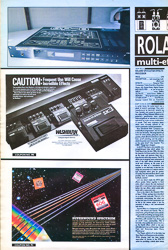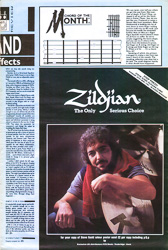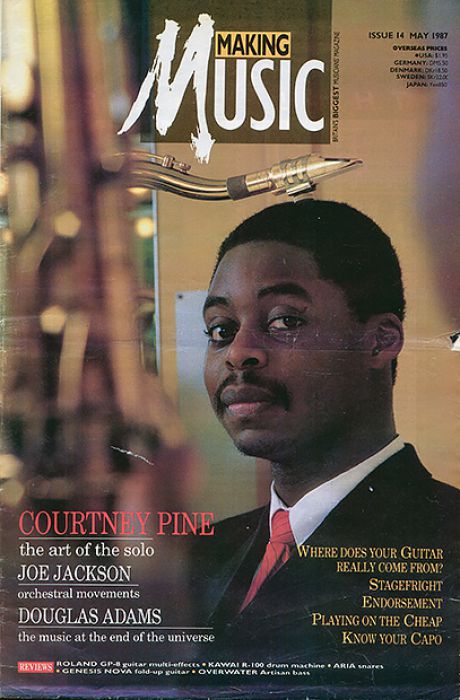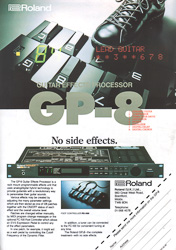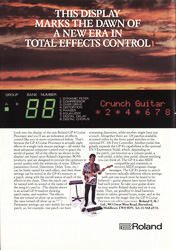Magazine Archive
Home -> Magazines -> Issues -> Articles in this issue -> View
Roland GP8 multi-effects | |
Article from Making Music, May 1987 | |
rack guitar effects

OPINION
In earlier times, the pedal board was a plank of esoteric parentage. They were manufactured by electronic wizards (eg Pete Cornish), and owned by popstars of the calibre of Dave Gilmour; effects to the guitarist's specification were nailed/soldered/gaffa-ed or velcroed to a board, and wired up to give various combinations of sounds. They were expensive items, which were normally tailored to the owner's particular musical perversions.
Boss introduced their "computer-controlled effects programmer", the SCC-700, in the late Seventies. This large board had room for seven pedals, giving the user 32 patches, which allowed control over output level, on/off switching, and the order in which the pedals were connected. "All this at the same time!" they boasted. "For £1085." Things have changed.
In the GP-8 we have a very sensible, very straightforward idea which ushers The Pedal Board into the late 1980s; this takes the innards of all those pedals that clutter up the stage, and squeezes them into a long slim box with a big memory. The GP-8 allows you to program every parameter of each of the eight effects provided, and recall each memory at the press of a button or dink of a footswitch (not supplied, as we shall see). It also lets you assign any parameter to a volume control-type footpedal which gives far greater versatility than the individual effects could possibly have in isolation. Controllable feedback, anyone?
Let's see what's inside the GP-8: eight effects pedals, linked together in fixed order, (that's almost the only backward step) with a send/return insert point just before the last effect, which works jolly nicely with a micro-rack unit.
First in the chain is the Dynamic Filter (cf Boss T-Wah), perhaps best described as an automatic wah-wah. This in itself is moderately entertaining, but when you realise that any of its four parameters can be fed to the volume pedal, it has the potential of being a real foot-activated wah device.
Second Effect is a Compressor (cf Boss CS-2), with Attack and Sustain. This, er, compresses, giving the input extra sustain, and generally smoothing out lumpy levels.
Third noise processor is the OD-2 Turbo Overdrive, with variable Tone, Drive, and an on/off Turbo switchability. This is basically a fuzz pedal, but not as much so as the fourth effect, which is the considerably more raucous Distortion - simple Tone and Distortion here. Heavy Metalorama!
The Phaser, which is #5 in the chain, has Rate, Depth and Resonance as its variables. While phasing itself has been largely superceded by chorus, in the GP-8 it's useful for providing a subtle slow sweep, which can stop lush sounds being too overpowering.
Number six is a three-band Equalizer which gives ±15dB of boost or cut on High, Middle or Low, plus an adjustable output level.
The seventh effect is a DDL, offering up to 1 second (or 1000mS, as Roland put it) of delay, with a frequency response of 12kHz. Variables are Effect Level, Delay Time, and Feedback. Bung the feedback to the EV-5 footpedal, and you can do crucial dub reggae sound brews.
Last in the chain is a Digital Chorus, with Rate, Depth, Effect Level, Pre Delay, and Feedback as its changeables. It's sufficiently versatile to play flangers with on a high feedback setting.
The GP-8's 128 patches are stored in two groups, A and B, with eight banks of eight patches in each group. Editing is simple enough to suss out without the aid of the imaginatively phrased manual (what does 'amplituled' mean?): all variables are accessed by means of buttons on the front panel, and whichever parameter is being edited is indicated in the two line 16 digit LCD. You select the parameter (or 'prameter'), and change the values by twiddling the Alpha Dial. Easy.
The GP arrives from the factory already programmed up with a choice of selection of named patches, from five Lead Guitars sounds, to the more adventurous Phasorus, and Oowww Lead. There are plenty of duplicates in these programs, which gives the user lots of space to put together his own effects combinations. Not that those provided aren't useful — Chorus Strat is good, Fuzzy Heart is a warm chorused distortion, Synced Res/Dly sounds like Bill Nelson, Underwater? is weird... each of these only needs a slight tweak to change it to personal guitar requirements.
I confess I didn't plumb the full capabilities of the GP-8. My program changing was all button pushing on the front panel, as I wasn't supplied with an FC-100 foot controller, which enables the nimble footed player to switch between patches with his plates. This might have helped make up for the absence of a Bypass control on the main module — it's necessary to keep a blank patch (with all effects off) for use as such. Nor did I experiment with the MIDI capabilities of the GP-8, though I did have a vision of a stage set-up entirely MIDI driven, with the keyboard patches, keyboard effects, vocal effects, guitar effects, amp settings, all programmed to change at the same time. Stranger things have happened...
DECISION
It's wonderfully simple, logical, and intelligent; it's versatile enough not to standardise guitar sounds; and it comes already programmed with eminently useable settings. But it's expensive, and you'll need the £225 FC-100 and the £55 volume pedal to get the best ot it. With the latter, it's capable of things that no other effects unit can offer, giving the guitarist remarkably sensitive control over his sound.
£745 is a lot of money to pay for an effects set up all in one go. But add up the cost of the individual pedals, and then think on the extra versatility the GP-8 can give.
SPEC - ROLAND GP-8 GUITAR EFFECTS PROCESSOR
| PRICE | £745 |
| DESCRIPTION | rack mounting multi-effects unit |
| EFFECTS | Dynamic Filter, Compressor, Turbo Overdrive, Distortion, Phaser, EQ, Digital Delay, Digital Chorus |
| MIDI FACILITIES | er, yes: in/out/thru |
| INPUT | mono -20dBm |
| OUTPUTS | mono/stereo -20dBm x2 |
| MEMORY | 128 programmable patches |
| OTHER STUFF | Send/Return, External Control Out x2, Footswitch control access |
Publisher: Making Music - Track Record Publishing Ltd, Nexus Media Ltd.
The current copyright owner/s of this content may differ from the originally published copyright notice.
More details on copyright ownership...
Review by Jon Lewin
Help Support The Things You Love
mu:zines is the result of thousands of hours of effort, and will require many thousands more going forward to reach our goals of getting all this content online.
If you value this resource, you can support this project - it really helps!
Donations for April 2025
Issues donated this month: 1
New issues that have been donated or scanned for us this month.
Funds donated this month: £4.00
All donations and support are gratefully appreciated - thank you.
Magazines Needed - Can You Help?
Do you have any of these magazine issues?
If so, and you can donate, lend or scan them to help complete our archive, please get in touch via the Contribute page - thanks!




